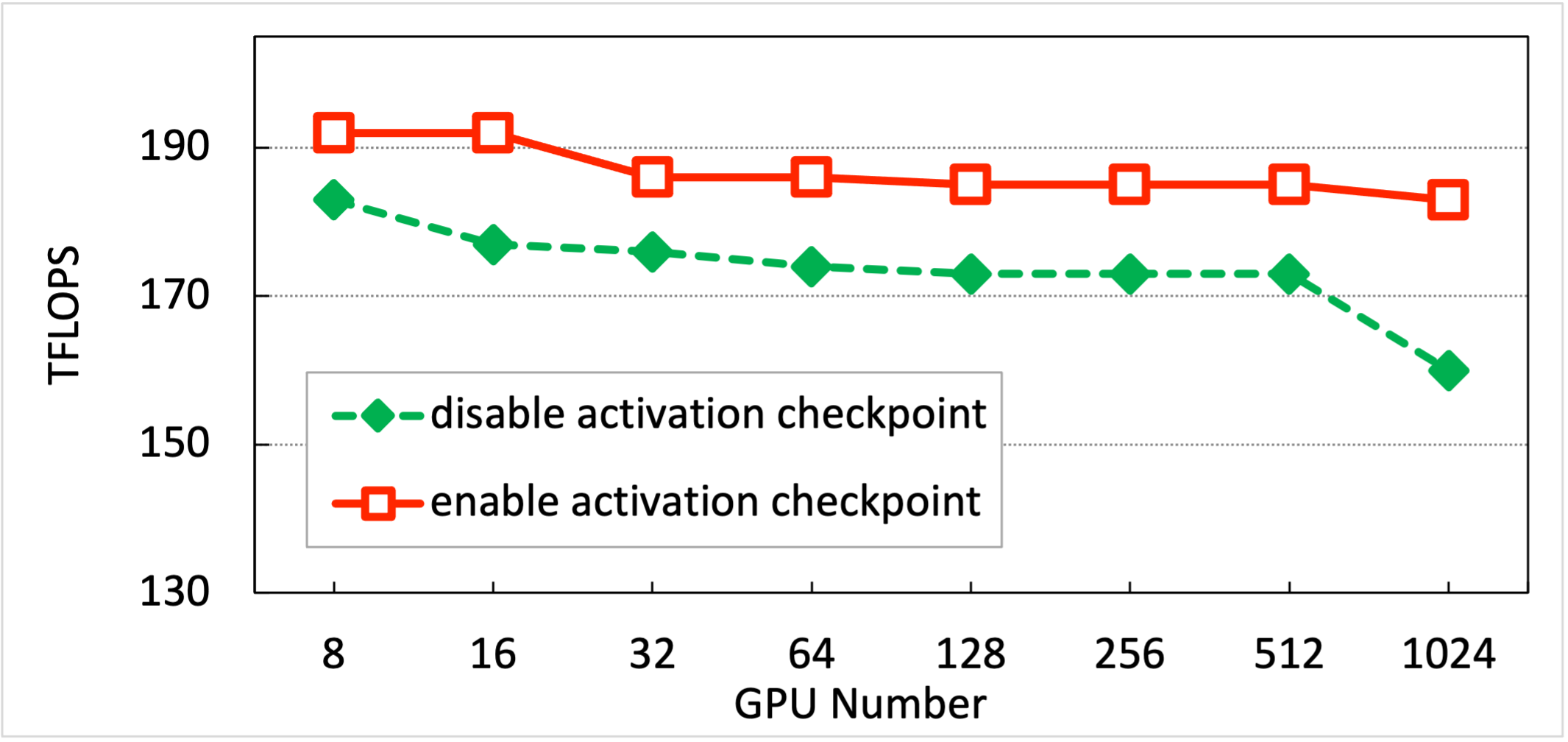4.5 KiB
Training Performance
InternLM deeply integrates Flash-Attention, Apex, and other high-performance model operators to improve training efficiency. It achieves efficient overlap of computation and communication, significantly reducing cross-node communication traffic during training by building the Hybrid Zero technique. InternLM supports expanding the 7B model from 8 GPUs to 1024 GPUs, with an acceleration efficiency of up to 90% at the thousand-card scale, a training throughput of over 180 TFLOPS, and an average of over 3600 tokens per GPU per second. The following table shows InternLM's scalability test data at different configurations:
| GPU Number | 8 | 16 | 32 | 64 | 128 | 256 | 512 | 1024 |
|---|---|---|---|---|---|---|---|---|
| TGS (Tokens/GPU/Second) | 4078 | 3939 | 3919 | 3944 | 3928 | 3920 | 3835 | 3625 |
| TFLOPS | 192 | 192 | 186 | 186 | 185 | 185 | 186 | 182 |
We tested the performance of training the 7B model in InternLM using various parallel configurations on a GPU cluster. In each test group, the number of tokens processed per GPU in a single iteration remained consistent. The hardware and parameter configurations used in the tests are shown in the table below:
| Hardware | Model |
|---|---|
| GPU | nvidia_a100-sxm4-80gb |
| Memory | 2TB |
| Inter-machine bandwidth | 4 * 100Gb RoCE |
| CPU | 128 core Intel(R) Xeon(R) CPU |
| Hyperparameters | tp=1 | tp=2 |
|---|---|---|
| micro_num | 4 | 4 |
| micro_bsz | 2 | 4 |
| seq_len | 2048 | 2048 |
The configuration of zero1 in InternLM determines the allocation range of optimizer states.
zero1=-1indicates that optimizer states are distributed across all data-parallel nodes (equivalent to Deepspeed Zero-1).- In the case of
zero1=8, tp=1, optimizer states are distributed within 8 GPUs in a single node, and the optimizer states remain consistent across different nodes.
Throughput Measurement
Throughput is defined as TGS, the average number of tokens processed per GPU per second. In this test, the training configuration had pack_sample_into_one=False and checkpoint=False. The test results are shown in the following table. When using zero1=8, tp=1, InternLM achieves an acceleration efficiency of 88% for training the 7B model with a thousand cards.
| Parallel Configuration | 8 GPUs | 16 GPUs | 32 GPUs | 64 GPUs | 128 GPUs | 256 GPUs | 512 GPUs | 1024 GPUs |
|---|---|---|---|---|---|---|---|---|
| (tp=1, zero1=-1) | 4062 | 3842 | 3752 | 3690 | 3571 | 3209 | 2861 | 2271 |
| (tp=1, zero1=8) | 4078 | 3939 | 3919 | 3944 | 3928 | 3920 | 3835 | 3625 |
| (tp=2, zero1=-1) | 3822 | 3595 | 3475 | 3438 | 3308 | 3094 | 2992 | 2785 |
| (tp=2, zero1=4) | 3761 | 3658 | 3655 | 3650 | 3651 | 3653 | 3589 | 3486 |

FLOPS Testing
The computational workload of model training is based on the FLOPS calculation method described in the Megatron paper. To ensure constant FLOPS during training, the test configuration had pack_sample_into_one=True. The training used the following configuration:
| Activation Checkpointing | tp | zero-1 | seq_len | micro_num | micro_bsz |
|---|---|---|---|---|---|
| Disabled | 1 | 8 | 2048 | 4 | 2 |
| Enabled | 1 | 8 | 2048 | 1 | 8 |
The test results are shown in the table below. InternLM can achieve >180 TFLOPS for 7B model on thousand-card scale.
| Activation Checkpoint | 8 GPUs | 16 GPUs | 32 GPUs | 64 GPUs | 128 GPUs | 256 GPUs | 512 GPUs | 1024 GPUs |
|---|---|---|---|---|---|---|---|---|
| Disabled | 183 | 177 | 176 | 174 | 173 | 173 | 173 | 160 |
| Enabled | 192 | 192 | 186 | 186 | 185 | 185 | 186 | 182 |
